View: tarantula spider (Theraphosidae) Family: tarantula spiders spiders migalomorphic Class: arachnids arthropod Dimensions: leg span: about 20 cm weight: up to 150 g lifespan: about 20 years
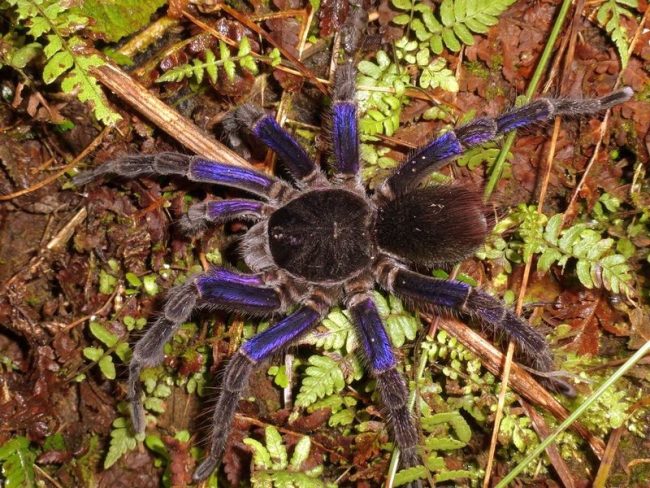
Scary and terrible monster or cute furry pet? For some, the tarantula spider has become a favorite inhabitant of the personal terrarium. One of the largest in the world, these insects can be incredibly beautiful and wildly charming
Content
- 0.1 Content
- 1 Habitat
- 2 Characteristic
- 3 Appearance
- 4 Key Features
- 5 Nutrition
- 6 Reproduction
- 7 Contents
Content
Contents
- Habitat
- Characteristic
- Appearance
- Key Features
- Nutrition
- Breeding
- Content
Scary and terrible monster or cute furry pet? For some, tarantula spiders have become the favorite inhabitants of the personal terrarium. One of the largest in the world, these insects can be incredibly beautiful and wildly charming.
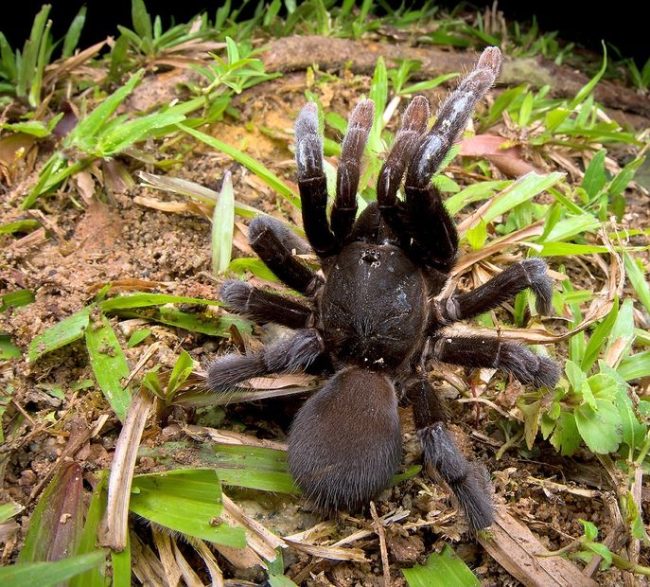
There is practically no continent where the tarantula would not live. But especially they like in warm countries
Habitat
There is practically no continent where the tarantula would not live. Video about this beast about eight legs indicates that you will not meet him except in Antarctica. The population density of these spiders is different countries varies. For example, in Europe you will not meet them often, there they chose only Spain, Italy and Portugal.
Tarantulas like where it’s warm – in Africa, South America, Australia and Oceania. There are types of spiders that are more to your liking settle in moist places, located in the crowns of trees equatorial forests. Other shaggy octopuses like more dry climate, they choose semi-desert.
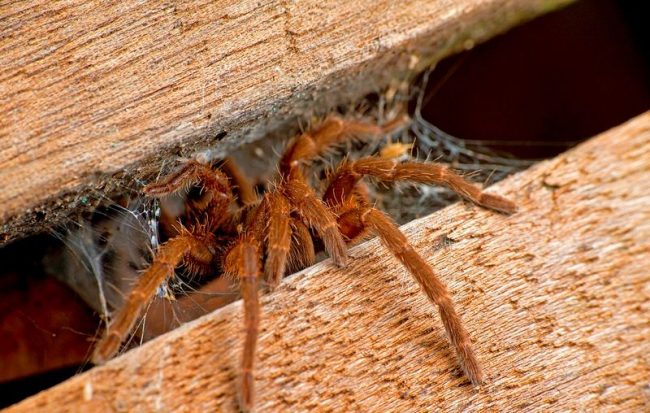
Tarantulas are protected by combing poisonous hairs from the abdomen or bites. The latter may be dry or toxic substances. As for the hairs, their contact with eyes and skin or into the lungs is not fatal, although it may cause an allergic reaction
Characteristic
While spaceships plow the expanses of our endless universe, scientists on earth have not yet figured out spiders tarantulas. A number of their genera have already been studied, here they are:
- Aviculariinae
- Eumenophorinae
- Harpactirinae
- Ischnocolinae
- Ornithoctoninae
- Phlogius
- Poecilotheriinae
- Selenocosmiinae
- Selenogyrinae
- Stromatopelminae
- Theraphosinae
- Thrigmopoeinae
But do not relax! There are up to several dozens of species, listing which may take quite a lot time.
There are varieties of tarantulas spiders that scientists have really not studied and everyone is debating where to identify them. In many the sources of these insects are grouped under the common “name” – other types of tarantulas. Here they are: Ami Perez-Miles, Brachionopus Pocock, Cardiopelma Vol, Cubanana Ortiz, Kochiana Fukushima, Nagahama & Bertani, Magulla Simon, Proshapalopus Mello-Leita ~ o.
The tarantula uses poison only to paralyze its sacrifice, but not poison. It kills the tarantula completely mechanically, striking with sharp chelicera. However, the reaction to poison in small animals or children can be so strong that without timely “suppression” of symptoms can lead to fatal исходу
There are subspecies within these poorly studied species. So if you dream that you have a tarantula spider living at home, which you buy Today they offer many real and online stores work hard with a choice of this variety.
Tarantulas are protected by combing poisonous hairs from the abdomen or bites. The latter may be dry or toxic substances. As for the hairs, their contact with eyes and skin or into the lungs is not fatal, although it may cause an allergic reaction.
It’s important to understand that any bite can be poisonous tarantula spider. A photo of his chelicera suggests that this is still and painful enough. The “teeth” of the spider can grow up to 2.5 cm in length. However, deadly poison tarantulas are not considered, at least least cases of death of a person from spider bite. People go to the hospital due to the reaction of the body to spider venom. Fever, seizures may occur, or severe allergy. Symptomatic means in this case will be quite enough.
The spider uses poison only to paralyze its victim, but do not poison. Kills the tarantula completely mechanically, inflicting punches with sharp chelicera. However, the reaction to poison in small animals or children can be so strong that without timely “suppression” of symptoms can lead to death.
Interesting! In danger, the tarantula may emit a hiss that is sometimes clearly audible within a radius of 15 meters.

The tarantulas have many colors, from deep brown and black and white to bright blue, red-black and orange. From the front, if you look closely, the eyes and mouth organs are visible
Appearance
The body structure of different species of tarantulas is approximately the same. The attention is drawn to the relatively large fluffy abdomen passing into a massive torso-head. The legs are long strong and also fluffy. Tarantulas have many colors, from deep brown and black and white to bright blue, red and black and orange. From the front, if you look closely, the eyes and mouth are visible organs.

Despite having eight eyes, the tarantula spider has very poor vision. Therefore, as a guide, he uses his villi on body, which captures the slightest vibration of the air
Key Features
Conventionally, tarantula spiders are usually divided into three types:
- Burrows
- Ground
- Woody
Interesting! At certain times, the tarantula may slightly change their orientation with regard to lifestyle. If it was a larva larva, then, becoming an adult, a spider can spend a lot of time on the surface of the earth.
Despite having eight eyes, tarantulas have very poor vision. Therefore, they use their villi as a guideline on the body, which capture the slightest vibration of the air.
The age of spiders should be considered not molten for years, but molts. First a little spider is born – a nymph who can absolutely do not need food. After a couple of links the nymph becomes larva or young spider. After the next skinning птицееда считают взрослой особью
The age of spiders should be considered not molten for years, but molts. First a little spider is born – a nymph who can absolutely do not need food. After a couple of links the nymph becomes larva or young spider. After the next skinning the tarantula is considered an adult.
It happens that when molting, the spider could not pull out some paws from an old shell. Then he drops them like a lizard tail. The foot is restored during subsequent links. FROM with each such change of “skin” the tarantula significantly increases in sizes, up to one and a half times, and also its coloring and body proportions, as evidenced by the photo and description of the spider tarantula.
Interesting! Females live much longer males. This is because upon reaching puberty males stop molting, in females this process continues a very long time. Significantly extend the life of the spider using thoughtful feeding and temperature conditions.
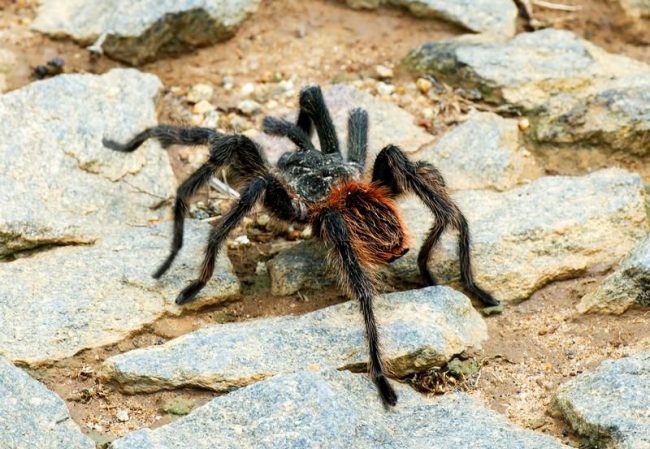
A tarantula spider is by nature an omnivorous predator, it eats everything moving and smaller in size. This includes insects, small reptiles and rodents, and, naturally, birds
Nutrition
Tarantulas are by nature omnivorous predators, they eat everything moving and smaller in size. This includes insects, small reptiles and rodents, and, of course, birds.
- In the summer, you can catch grasshoppers, caterpillars and flies. It is important that they do not have pesticides.
- The spider will like to hunt “naked” mice or adults mice.
- Locusts, frogs are sold as feed in the bird market crickets, flour worms, zofobuses, small lizards.
- You can breed marble cockroaches and feed them tarantula. Even if these insects accidentally run around the house, they won’t live for a long time because conditions.
- The water in the drinker must be changed as it becomes dirty. And the remnants eaten “booty” – a web interspersed with the shell of the victim – must be removed immediately, as ticks may be acquired there. For a healthy tarantula, they are not dangerous, but during molting they can cause him irreparable harm.
Interesting! A spider can do without food two years. Moreover, he will behave actively, such starvation for him is something normal.
Before and after molting for about 1 to 3 months, the tarantula may refuse food, be lethargic. Do not give him at this time “feed”, as the victim in this case may become exhausted molting tarantula spider. Photos on the Internet will help determine the state of your pet. In any case, not eaten “feed” cannot be left in the cage, even if the spider is in normal condition.
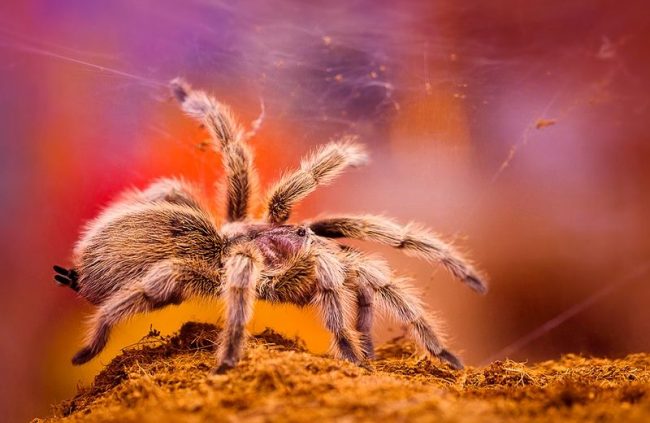
After a ritual dance testifying to partners that they relate to one species, mating occurs. During this of the process, the male transfers seminal fluid into the female, which until This is placed on a specially woven web, where it passes an act of love
Breeding
After a ritual dance testifying to partners that they relate to one species, mating occurs. During this of the process, the male transfers seminal fluid into the female, which until This is placed on a specially woven web, where it passes an act of love.
At the end of the mating, the male should escape as soon as possible. The female, becoming hungry, becomes incredibly aggressive, therefore she can eat a negligent boyfriend.
A few months later, the female appears cocoon filled eggs from 50 to 2,000 pieces. The future mother zealously guards him in during the week. Then the nymphs hatch, which for a while Spiders live on the back, and then creep out.
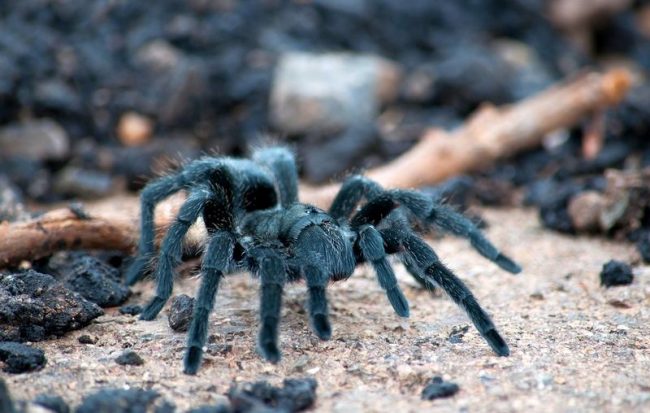
A tarantula spider can live at home. To do this, he special terrarium needed
Content
Glass house is ideal for a tarantula. terrarium. It should not be too spacious, a spider is enough, if the place of the monastery will be twice as long as its length in scope legs. Safe for land and burrow insect height – 20 cm. The tree spider needs to pick up a house higher and provide it with a thick snag. For the norn, you need to pour coconut substrate, peat to the bottom or vermiculite 5-10 cm thick.
Do you think the content of one tarantula spider is an achievement? What about four hundred? Watch the video where shaggy breeding octopuses turned into a real hobby.






